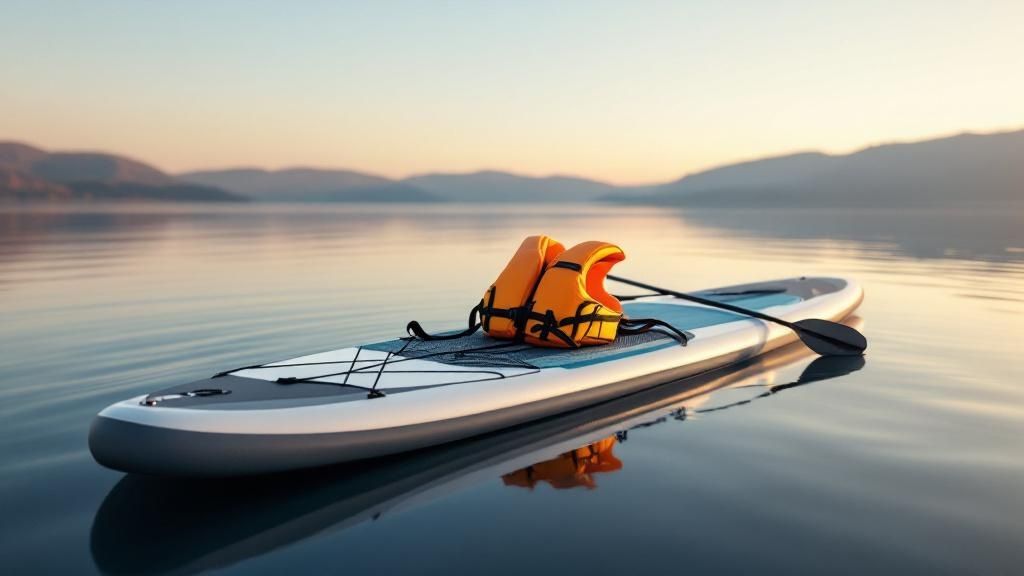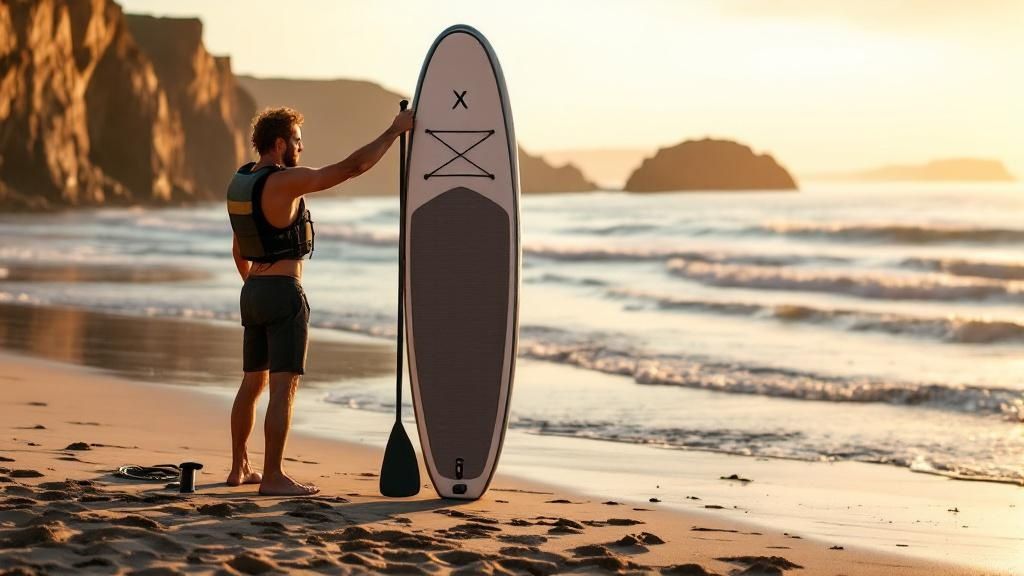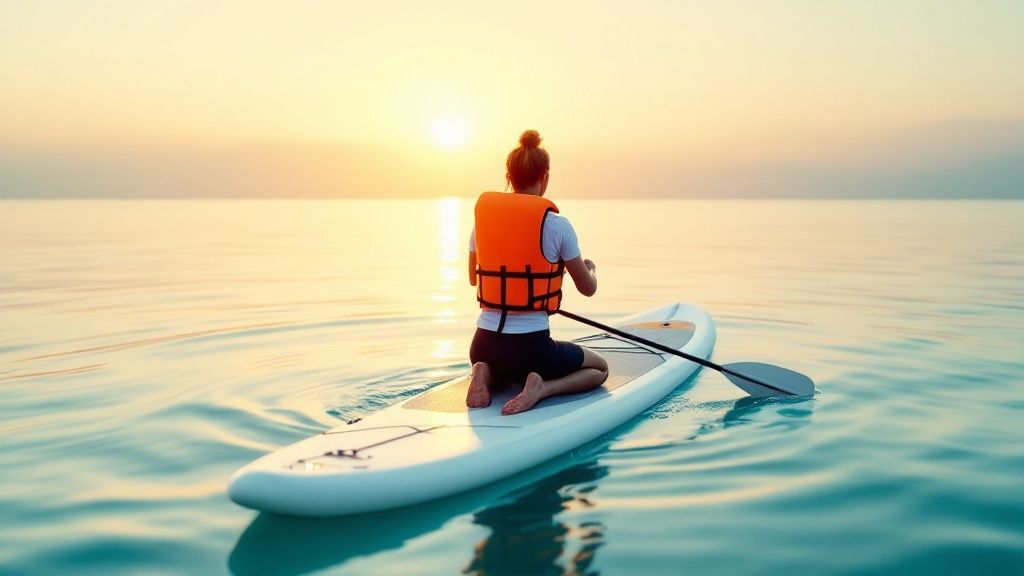24 Top Tips to Get You Stand-Up Paddle Boarding Quickly

Killer Stand Up Paddle Board Tips You Need in 2025
Stand-Up Paddle Boarding (SUP) has gained immense popularity as a thrilling water sport. Whether you're a beginner or an experienced enthusiast, mastering the art of paddle boarding can enhance your experience and make it even more enjoyable. To help you get started and excel in this exciting sport, we have compiled 23 top tips from the Stand up paddle board world. These tips cover everything from basic techniques to essential SUP safety guidelines, ensuring that you have a fantastic time on the water.
1. Learn How to Swim
Although SUP provides safety measures like leashes and life jackets, being proficient in swimming is essential. Not only will it enhance your overall experience, but it will also ensure your safety while participating in water sports. Swimming skills will give you confidence in the water and eliminate any fear of falling off the paddle board.
2. Begin on Solid Ground
Before venturing into the water, it's recommended to practice on solid ground first. Familiarize yourself with the technique of transitioning from a kneeling position to standing up on the paddle board. This will help you become comfortable with the motions before dealing with the instability of the water.
3. Choose the Perfect Launch Spot for your Stand up Paddle Board
Selecting an ideal launch spot can significantly impact your Stand-Up Paddle Boarding experience. Opt for a sunny and calm day when you can truly enjoy being in the water. Find a sandy beach with shallow water, suitable for swimming. Avoid areas with mucky lake or river bottoms, rocky surfaces, or excessive water vegetation.
4. Start on Your Knees
To develop a sense of stability and balance, it's advisable to start paddle boarding on your knees. Remaining in a kneeling position allows you to adapt to the feel of the board on the water. This technique is particularly useful if you're new to paddling sports, as it allows you to focus on one aspect at a time.
5. Stand Up Smoothly
Once you're ready to stand up on the paddle board, remember the sensation of doing so on solid ground. Stand up in one fluid motion, ensuring that you bring your paddle along with you. For added stability, plant the paddle in the water or position it in front of you on the board, acting as a third leg.
6. Maintain a Wide SUP Stance
As you transition from your knees to standing, maintain a wide stance on the paddle board. Make sure your knees are on either side of the handle in the middle of the board. Keeping a wide stance promotes stability, reducing the chances of losing balance.
7. Find the Right Position on your Paddle Board
Stand in the center of the paddle board, straddling the middle handle. Keep your knees relaxed and avoid locking them, allowing for better balance and maneuverability.
8. Hold the SUP Paddle Correctly
Holding the paddle correctly is crucial for efficient paddling. The most common mistake beginners make is holding the paddle backward. Ensure that the bent angle of the paddle's "throat" points towards you, with the face of the blade oriented forward. This orientation minimizes drag and maximizes efficiency, leading to less fatigue during your paddleboarding session.
9. Maintain Paddle Board Momentum
Similar to riding a bicycle, paddle boarding becomes easier once you're in motion. After standing up on the board, get your paddle in the water and start moving as soon as possible. Sustaining forward momentum provides stability and control. If you need to pause, either keep the paddle blade in the water or rest it gently on the board to maintain balance.
10. Use a SUP Leash
Attaching a leash to your ankle or calf is essential for your safety while paddle boarding. In case of a fall, the leash prevents your board from drifting away, allowing for an easy retrieval. Ensure that the leash is securely fastened to your board and fits snugly around your ankle.
11. Learn How to Fall Safely
Falling off the paddle board is part of the learning process. To minimize the risk of injury, practice falling away from the board. If you're using a solid board, it's crucial to avoid landing on it to prevent damage. Additionally, hold onto your paddle during a fall to ensure you don't lose it in the water.
12. Master Climbing Back on our Paddle Board
Practicing the skill of climbing back onto your paddle board is essential. To do this effectively:
- Swim to one side of the paddleboard's centre.
- Use one hand to grab the handle and the other to hold the far edge.
- Kick your feet out near the water's surface and propel your upper body onto the board by combining a powerful kick with a pulling motion.
- Rotate to face the front of the board, get on your knees, and then stand up when you feel stable.
Consider removing your traditional foam Personal Flotation Device (PFD) to make climbing back on the board easier. Ensure that you secure the PFD to the board using bungee cords to prevent it from floating away.
13. Utilize Long, Smooth Strokes
When paddling, avoid poking the water with your paddle. Instead, reach out in front of you with slightly bent knees, submerge the blade, and pull it back towards your feet as you straighten up. Engage your entire core and upper body in each stroke to generate power efficiently and reduce strain on your shoulders.
14. Look Ahead, Not Down
While paddling, it's common for beginners to keep their eyes fixed on their feet or the board. However, focusing on the water and the horizon ahead improves your balance and stability. Maintain a forward gaze to paddle more effectively.
15. Relax and Enjoy
Relax your body, keep your legs and knees flexible, and allow yourself to feel the movement of the water beneath you. When encountering waves or boat wake, let your knees move in response to the water's motion. Remember to have fun and take breaks by kneeling or sitting on your board when needed.
16. Learn Various Paddle Strokes
To enhance your paddleboarding skills, familiarize yourself with different paddle strokes. By mastering basic techniques such as steering, turning, bracing, and stopping, you can paddle for longer durations without the need for constant paddle switching. If you have previous experience with canoeing or kayaking, you'll have a head start in understanding paddle technique on a SUP board.
17. Practice SUP Bracing Techniques
Bracing is a useful technique that helps you regain balance when the board feels unstable. By using the face of the paddle blade on the water's surface, you can stabilize yourself. Practice different bracing techniques until they become second nature. Online resources, such as articles and videos from reputable sources like Paddling.com, can provide additional guidance.
18. Check the Weather Forecast
Before embarking on a paddleboarding adventure, always check the weather forecast. Understanding the expected temperature, wind speed, wind direction, and the potential for storms is crucial for planning a safe outing. Avoid paddleboarding in high winds, as it can make the experience more challenging, particularly for beginners. If you hear thunder, it's essential to leave the water immediately to avoid the risk of lightning strikes.
19. Be Prepared for Wind and Waves
In case you encounter challenging weather conditions, such as high winds or waves, it's important to be prepared. If the wind is strong, dropping to your knees while paddling back to shore can provide more stability and control. Standing up in windy conditions can make it difficult to navigate, as the wind can act as a sail and push you off course. Additionally, if you come across waves or boat wakes, turn your board to face them head-on for better stability. You can also drop to your knees for added support and balance.
Remember, adjusting your technique based on the conditions will ensure a safer and more enjoyable paddleboarding experience.
20. Dress Appropriately for the Conditions
It's important to dress according to the air and water temperature to ensure your comfort and safety. In hot weather, lightweight and breathable clothing is recommended. However, when the air or water is cold, it's crucial to protect yourself from hypothermia. Wear a wetsuit or a dry suit to prevent excessive heat loss. If the water is extremely cold or you're not adequately dressed, it's best to stay close to the shore or avoid paddleboarding altogether to prioritize your safety.
21. Wear a Personal Flotation Device (PFD)
Wearing a personal flotation device is essential, especially in open water, currents, or windy conditions. There are various comfortable and low-profile PFD options available, including inflatable ones. A PFD provides an added layer of safety and ensures that you stay afloat in case of an accident or fatigue.
22. Consider Taking Lessons
Investing in paddleboarding lessons, whether from a professional instructor or an experienced friend, is highly recommended. Lessons can significantly improve your technique, safety awareness, and overall enjoyment of the sport. Learning from someone with expertise will provide valuable insights and help you progress faster.
23. Practice Consistently
To enhance your paddleboarding skills, regular practice is key. Make an effort to spend as much time as possible on the water, honing your abilities and becoming comfortable with the paddleboard. With consistent practice, you'll gain confidence and be able to fully appreciate the beauty of the water and your surroundings.
24. Invest in a Quality SUP Paddle
While many paddleboards come with a paddle included, it's worth considering investing in a high-quality paddle. A lightweight, well-designed paddle can greatly enhance your paddleboarding experience. It reduces fatigue, improves efficiency, and provides better control and manoeuvrability. The paddle is your connection to the water, so choosing a good one can make a significant difference.
By following these 24 tips, you'll be well-equipped to embark on your stand-up paddleboarding journey with confidence, skill, and enjoyment. Happy paddling!
To find out more about our amazing carbon paddles click here




